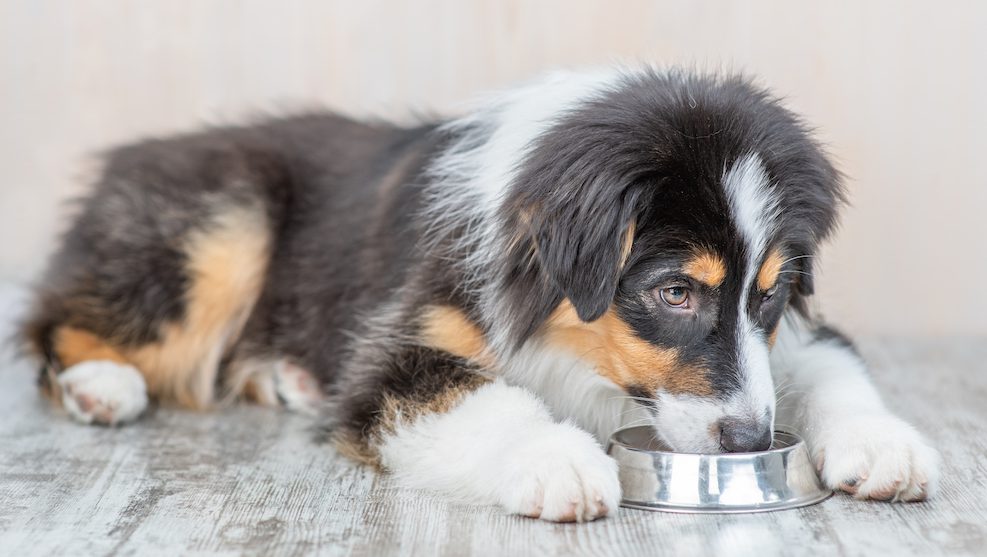Adequate water intake is crucial to dogs’ health. And while we humans can pour ourselves eight or so glasses of H2O each day, our canine friends rely on us to keep them hydrated. Here’s everything you need to know about making sure your best pal has enough to drink.
How much water should my dog drink?
As a general guideline, dogs should drink around one ounce of water per pound of body weight each day.
How can I help my dog drink enough water?
The best thing you can do to keep your dog hydrated is give them access to fresh, clean water throughout the day. While free-feeding is not a good idea, free drinking is a must. When you’re on the go, bring a supply of water and something your dog can drink out of. Bowls and bottles specifically designed for on-the-go dogs may make this easier.
If your dog doesn’t seem to be drinking enough, check that the bowl is clean and you’re changing the water frequently enough. Dogs may prefer water that’s cool or moving—so you can try pouring it in front of them or using a fountain-like dispenser.
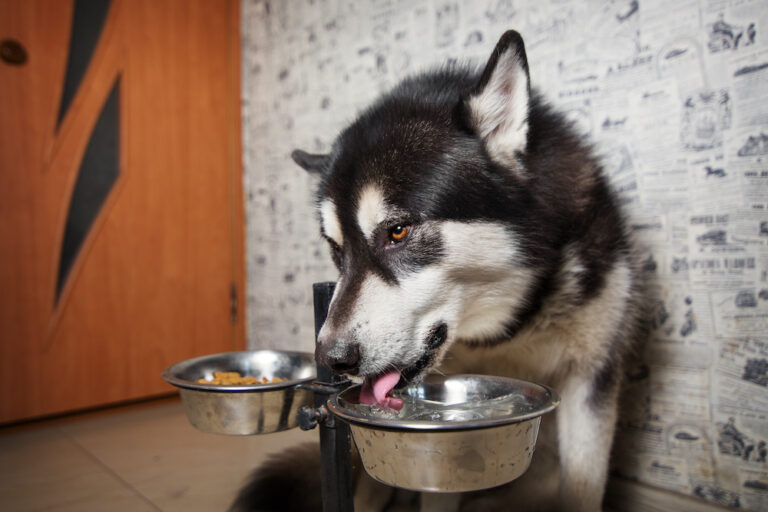
What should my dog drink out of?
Give your dog their own water bowl. Ceramic and stainless steel are popular options, and there are also silicone travel bowls that may be convenient. Many vets recommend avoiding plastic bowls, whose porous material is more easily chewed or scratched and can harbor bacteria. They can also cause allergic reactions around the mouth in some dogs. Plastic bowls may contain chemicals called bisphenols, which could be hazardous to your dog in the long term. Whatever bowl you use, keep a supply of fresh water in there and clean it every day.
What’s that pink stuff growing in my dog’s water bowl?
On the subject of cleaning, one organism that can grow in a dog’s water bowl is Serratia Marcescens, which has a distinctive pink color. While the bacteria won’t necessarily sicken your pup, it can cause serious issues in dogs with compromised immune systems. And bowls that don’t get regularly cleaned can grow other types of bacteria along with mold and yeast. It’s best to avoid this by treating your dog’s water bowl the way you would your own glass.
Should my dog drink out of the toilet?
No. While it’s technically true that your toilet is filled with fresh water from the municipal supply, most commodes come into frequent contact with human waste, not to mention all manner of non-edible cleaning products. If you wouldn’t drink out of your toilet, you shouldn’t take the risk of letting your dog do so instead of setting aside a few seconds to fill their more-sanitary water bowl.
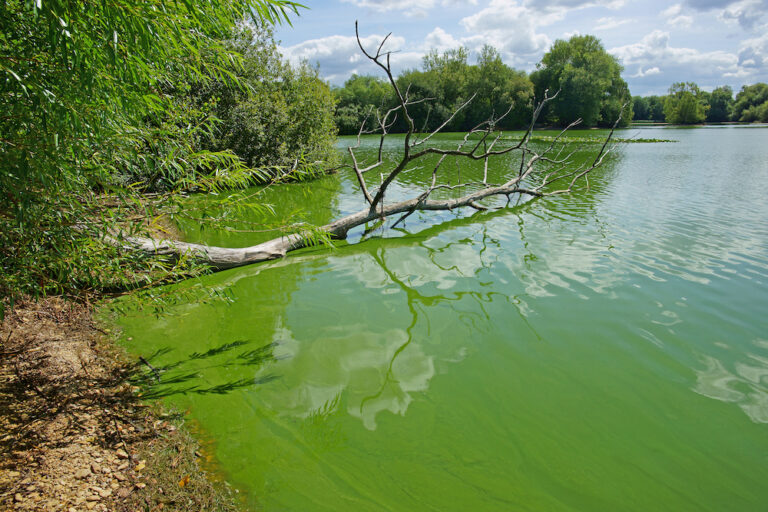
Don’t let your dog drink from ponds, lakes, rivers, or puddles.
What about puddles?
Nope. Puddles, ponds, lakes, and rivers can contain dangerous pathogens like giardia, leptospirosis, and toxic algae. Cyanobacteria, colloquially known as “blue-green algae,” is one potentially fatal hazard that’s been in the news lately and may be present in lakes and rivers—especially during warm, sunny weather. In some cases, dogs who’ve gone swimming in ponds with toxic algae have become ill just by licking water off of their fur. You’re much better off bringing a supply of fresh, clean water for your dog to drink while you’re out on a walk.
How does my dog’s diet impact their hydration?
Food and snacks can be a good source of water for dogs. Fresh food retains the natural moisture of the meat and vegetables it’s made from; kibble, which is processed multiple times at extremely high temperatures and dried to allow for an extended shelf life, does not. A lack of moisture is one of the many drawbacks of feeding dry food. If your dog eats a fresh diet, and gets fresh snacks like fruit, they may have an easier time staying hydrated than if they depend on a dry diet.
What percentage of a dog is water?
Experts estimate that dogs are 80% water.
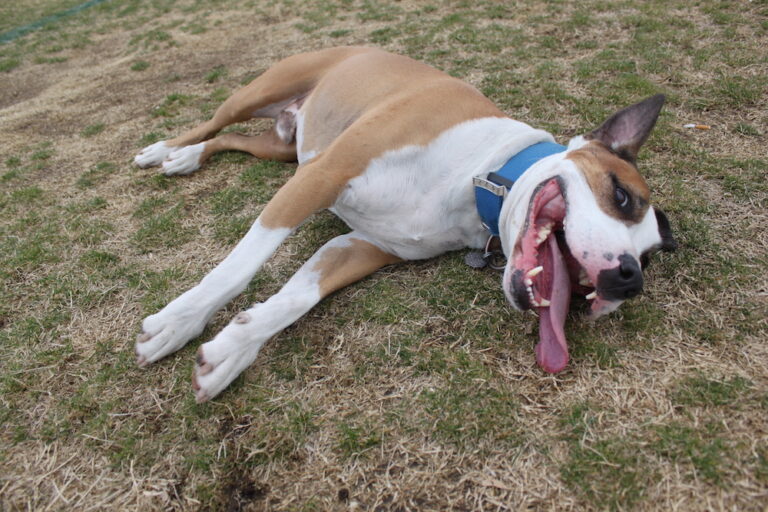
What are the signs of dehydration in a dog?
Among the warning signs that your dog is dehydrated are a dry nose, panting, fatigue, dry gums, and thick saliva. One simple way you can test for dehydration is to gently grab some skin on your dog’s back using your thumb and forefinger, then release it. The skin should return to its original position quickly. If it moves back slowly or doesn’t move at all, that’s a sign of dehydration. Another vet-approved test: place your finger in your dog’s mouth against the gum surface; it should feel wet. If it feels dry or sticky, this can be another indicator of dehydration.
What should I do if my dog is dehydrated?
If your dog is dehydrated right now, see if you can get them to drink a little clean, fresh water and contact your veterinarian as soon as possible. Don’t try to deal with the situation all by yourself—if a dehydrated dog drinks a large quantity of water all at once, they may vomit. A vet can assess the severity of the situation, and may administer IV or subcutaneous fluids.
What can cause dehydration in a dog?
Dogs can become dehydrated due to heat stroke, diarrhea, or vomiting, as well as from various illnesses. If your dog is dehydrated, work with your veterinarian to investigate further and formulate a treatment plan.
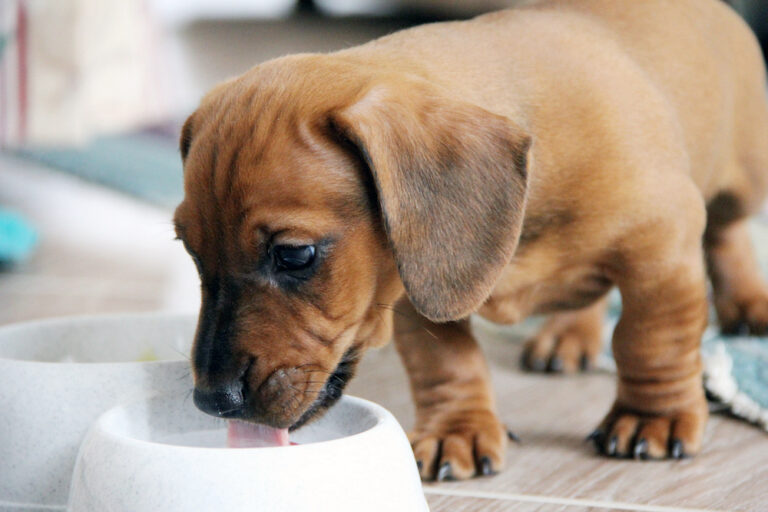
What does it mean if my dog is suddenly drinking way more than usual?
Dogs can sometimes get very thirsty for the same reasons a person would—it’s a hot day, they’ve been exercising a lot, or they’ve gone a bit too long without drinking water. But if you notice that your dog seems much thirstier than their baseline, your best bet is to contact a veterinarian. A wide range of conditions, including kidney problems, Cushing’s disease, pyometra, and diabetes, can lead to excessive thirst in dogs, as can some medications. Your vet will be able to help get to the bottom of any sudden or drastic changes in your dog’s behavior.
What if my dog isn’t drinking water?
Just as a dog might drink more water in some ordinary situations, a dog might drink less if the weather cools down or they’re not as active as usual. If you’ve switched from dry to fresh food, or you’re feeding water-rich treats like fresh fruit, that may have an impact on how much they’re drinking in a day. But if you notice that your pup has stopped drinking for no apparent reason, you should try to figure out why. It’s possible that their bowl should be refilled with new water or cleaned. If the dog’s water supply or bowl has changed recently, try mixing it up—there may be something about the water itself or the vessel that they don’t like. Dogs with dental disease can become sensitive to hot and cold sensitivities, which could cause them to balk at cold water.
If they don’t want to drink, remember that dogs have an excellent sense of smell and may be able to perceive a problem with the water that is not evident to you. If your dog won’t drink and you’ve exhausted immediate options like giving them fresh water, contact your vet right away—their behavior could be related to an injury or illness, and it’s important that you address it now so that they can get the fluids they need.
Pet health is an important topic. That’s why The Farmer’s Dog editorial team carefully vets and reviews every piece of content we publish. We deliver evidence-based advice and medically reviewed facts that focus on pet nutrition, health, and well-being. The mission of this site is to help people provide the best care possible for their dogs by publishing only trustworthy, accurate, and timely health information from a group of passionate experts.



